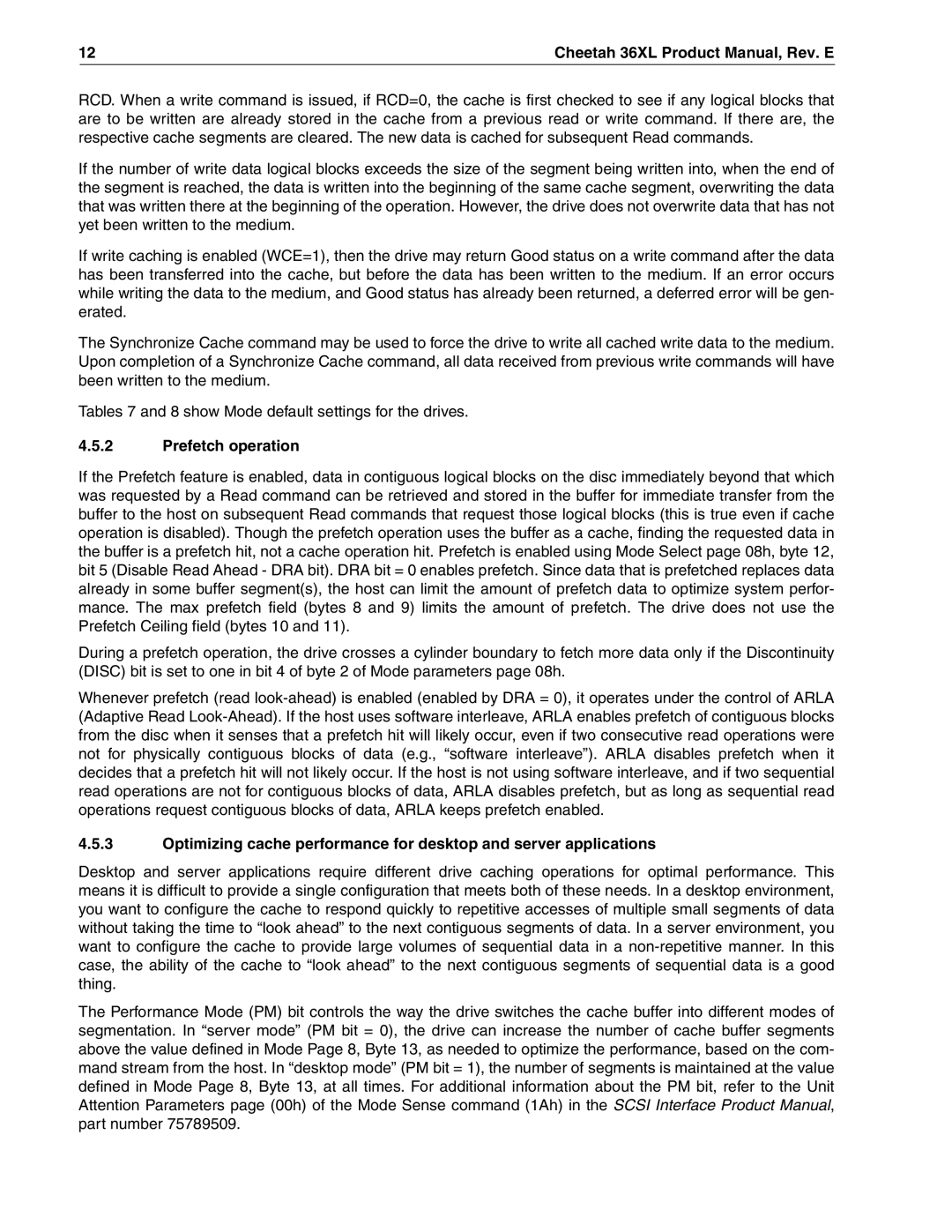12 | Cheetah 36XL Product Manual, Rev. E |
RCD. When a write command is issued, if RCD=0, the cache is first checked to see if any logical blocks that are to be written are already stored in the cache from a previous read or write command. If there are, the respective cache segments are cleared. The new data is cached for subsequent Read commands.
If the number of write data logical blocks exceeds the size of the segment being written into, when the end of the segment is reached, the data is written into the beginning of the same cache segment, overwriting the data that was written there at the beginning of the operation. However, the drive does not overwrite data that has not yet been written to the medium.
If write caching is enabled (WCE=1), then the drive may return Good status on a write command after the data has been transferred into the cache, but before the data has been written to the medium. If an error occurs while writing the data to the medium, and Good status has already been returned, a deferred error will be gen- erated.
The Synchronize Cache command may be used to force the drive to write all cached write data to the medium. Upon completion of a Synchronize Cache command, all data received from previous write commands will have been written to the medium.
Tables 7 and 8 show Mode default settings for the drives.
4.5.2Prefetch operation
If the Prefetch feature is enabled, data in contiguous logical blocks on the disc immediately beyond that which was requested by a Read command can be retrieved and stored in the buffer for immediate transfer from the buffer to the host on subsequent Read commands that request those logical blocks (this is true even if cache operation is disabled). Though the prefetch operation uses the buffer as a cache, finding the requested data in the buffer is a prefetch hit, not a cache operation hit. Prefetch is enabled using Mode Select page 08h, byte 12, bit 5 (Disable Read Ahead - DRA bit). DRA bit = 0 enables prefetch. Since data that is prefetched replaces data already in some buffer segment(s), the host can limit the amount of prefetch data to optimize system perfor- mance. The max prefetch field (bytes 8 and 9) limits the amount of prefetch. The drive does not use the Prefetch Ceiling field (bytes 10 and 11).
During a prefetch operation, the drive crosses a cylinder boundary to fetch more data only if the Discontinuity (DISC) bit is set to one in bit 4 of byte 2 of Mode parameters page 08h.
Whenever prefetch (read
4.5.3Optimizing cache performance for desktop and server applications
Desktop and server applications require different drive caching operations for optimal performance. This means it is difficult to provide a single configuration that meets both of these needs. In a desktop environment, you want to configure the cache to respond quickly to repetitive accesses of multiple small segments of data without taking the time to “look ahead” to the next contiguous segments of data. In a server environment, you want to configure the cache to provide large volumes of sequential data in a
The Performance Mode (PM) bit controls the way the drive switches the cache buffer into different modes of segmentation. In “server mode” (PM bit = 0), the drive can increase the number of cache buffer segments above the value defined in Mode Page 8, Byte 13, as needed to optimize the performance, based on the com- mand stream from the host. In “desktop mode” (PM bit = 1), the number of segments is maintained at the value defined in Mode Page 8, Byte 13, at all times. For additional information about the PM bit, refer to the Unit Attention Parameters page (00h) of the Mode Sense command (1Ah) in the SCSI Interface Product Manual, part number 75789509.
